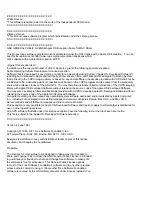
5. Test the grounding continuity between a conductive area on the system frame and the ground pin on
the plug of each input-power cable.
6. Initiate one of the following procedures after you complete testing the grounding continuity,
depending on the outcome of the test.
• If the test is successful, reconnect any cables that were removed, and power on any system nodes
that were powered off.
• If the test was not successful, ensure that all cables are securely connected. If the test still fails, test
the individual system components. Before you test the individual components, remove all cables
from the components. If any component test fails, replace the component. After you test each
component and replace any failing ones, repeat the complete system test by returning to step “1” on
• Test the system node, from the frame to the ground pin of the input power receptacle.
Emergency power-off shutdown
The system supports emergency power-off (EPO) shutdowns.
Handling static-sensitive devices
Ensure that you understand how to handle devices that are sensitive to static electricity.
Attention: Static electricity can damage electronic devices and your system. To avoid damage,
keep static-sensitive devices in their static-protective bags until you are ready to install them.
To reduce the possibility of electrostatic discharge, observe the following precautions:
• Limit your movement. Movement can cause static electricity to build up around you.
• Handle the device carefully, holding it by its edges or frame.
• Do not touch solder joints, pins, or exposed printed circuitry.
• Do not leave the device where others can handle and possibly damage the device.
• While the device is still in its antistatic bag, touch it to an unpainted metal part of the system unit for at
least 2 seconds. (This action removes static electricity from the package and from your body).
• Remove the device from its package and install it directly into your system, without putting it down. If it
is necessary to put the device down, place it onto its static-protective bag. (If your device is an adapter,
place it component-side up.) Do not place the device onto the cover of the system or onto a metal table.
• Take additional care when you handle devices during cold weather. Indoor humidity tends to decrease
in cold weather, causing an increase in static electricity.
Environmental notices
This information contains all the required environmental notices for IBM Systems products in English and
other languages.
The IBM Systems Environmental Notices includes statements on limitations, product information, product
recycling and disposal, battery information, flat panel display, refrigeration and water-cooling systems,
external power supplies, and safety data sheets.
xxvi SAN Volume Controller : Model 2145-SV1 Hardware Installation Guide
Summary of Contents for SAN Volume Controller 2145-SV1
Page 1: ...IBM SAN Volume Controller Hardware Installation Guide IBM...
Page 6: ...vi...
Page 48: ...16 SAN Volume Controller Model 2145 SV1 Hardware Installation Guide...
Page 62: ...30 SAN Volume Controller Model 2145 SV1 Hardware Installation Guide...
Page 72: ...40 SAN Volume Controller Model 2145 SV1 Hardware Installation Guide...
Page 168: ...136 SAN Volume Controller Model 2145 SV1 Hardware Installation Guide...
Page 176: ...144 SAN Volume Controller Model 2145 SV1 Hardware Installation Guide...
Page 178: ...146 SAN Volume Controller Model 2145 SV1 Hardware Installation Guide...
Page 182: ...150 SAN Volume Controller Model 2145 SV1 Hardware Installation Guide...
Page 192: ...160 SAN Volume Controller Model 2145 SV1 Hardware Installation Guide...
Page 193: ......
Page 194: ...IBM...
















































